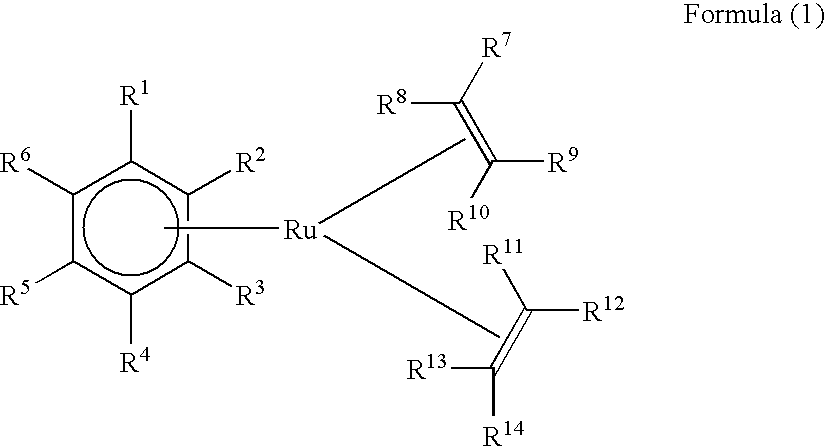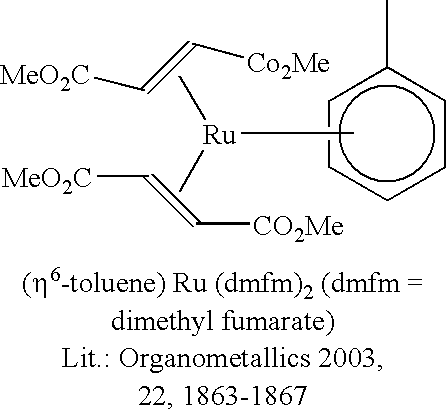Hydrosilylation process in the presence of ruthenium catalyzers
a technology of ruthenium catalyzer and hydrosilylation process, which is applied in the direction of physical/chemical process catalyst, organic compound/hydride/coordination complex catalyst, etc., can solve the problems of high cost of platinum, pt catalysts are distinctly inferior to common pt catalysts in reactivity and selectivity, and the rate and selectivity of non-pt catalysts described to date for hydrosilylation is generally insufficien
- Summary
- Abstract
- Description
- Claims
- Application Information
AI Technical Summary
Problems solved by technology
Method used
Image
Examples
example 1
Hydrosilylation of HMe2SiO—[SiMe2O]x—SiMe2H (x≈13) (H-polymer 13) with 3-vinylheptamethyltrisiloxane
[0130]A mixture of 3.8 g (approx. 4 mmol) of H-polymer 13 and 1.99 g (8 mmol) of 3-vinylheptamethyltrisiloxane is admixed with the appropriate amount of an Ru catalyst (300 ppm of Ru) and stirred at 120° C. under an argon atmosphere. The hydrosilylation reaction (conversion, selectivity, yield) is analyzed by 1H NMR.
[0131]
ReactiontimeConversionSelectivityYieldCatalystRu(η4-COD)(η6-COT)1 h1007171Ru(η4-COD)(2-methallyl)21 h1006565Ru(η6-p-cymene)(η4-COD)1 h918376Ru(η6-toluene)(dmfm)21 h998786Ru(η6-C6H6)(η4-C6H8)1 h487938Ru(η6-C6H6)(η4-C6H8)2 h698458(η5-Cp*)Ru(Cl)η4-COD)1 h696948(η5-Cp*)Ru(Cl) η4-COD)2 h847058ComparativeExamplesRu(PPh3)3Cl22 h721914Ru(CO)3(PPh3)22 h757254RuCl3 * 3H2O2 h2201K2RuCl5 * XH2O2 h657549[RuCl2(CO)3]22 h931312CpRu(PPh3)2Cl2 h664429[Pt2(TMDVS)3],1 h1009191“Karstedtcatalyst”(100 ppm Pt)Legend:COD = 1,5-cyclooctadiene;COT = 1,3,5-cyclo-octatriene;dmfm = dimethyl fuma...
example 2
Crosslinking of an α,ω-divinylpolydimethylsiloxane with an SiH-Functional Polysiloxane at 120° C.
[0132]10 g of an α,ω-divinylpolydimethylsiloxane, viscosity η=500 mPa·s (name within Wacker VIPO 500) are admixed with the Ru catalyst (300 ppm of Ru based on the total mass of the mixture), mixed vigorously in a round-bottom flask while treating with ultrasound and admixed with 250 mg of an SiH-functional polysiloxane of the formula Me3SiO—[Si(H)Me-O]48—SiMe3 (name within Wacker V24 crosslinker) and mixed vigorously once again. The mixture is stirred in a preheated oil bath at 120° C. and 500 rpm under argon. The time until the gelation has progressed to such an extent that stirring with a magnetic stirrer bar is no longer completely possible is determined.
[0133]
GelationtimeCatalystRu(η4-COD)(η6-COT)25 sRu(η4-COD)(2-methallyl)21 min. 45 sRu(η6-p-cymene)(η4-COD)2 min. 40 sRu(η6-C6H6)(η4-C6H8)5 min.(η5-Cp*)Ru(Cl)η4-COD)8 min. 30 sComparative Examples[(p-cymene)RuCl2]238 min.Ru(CO)3(PPh3)2...
example 3
Crosslinking of an α,ω-divinylpolydimethylsiloxane with an SiH-Functional Polysiloxane at Room Temperature (Approx. 20° C.)
[0134]The mixture from Example 2 is left to stand under argon at room temperature (approx. 20° C.) and the time until the system is no longer free-flowing (“pot life”) is determined.
[0135]
“Pot life”CatalystRu(η4-COD)(η6-COT)1 min.Ru(η4-COD)(2-methallyl)22 h 10 min.Ru(η6-C6H6)(η4-C6H8)8 hComparative Examples[(p-cymene)RuCl2]2>1 dRu(CO)3(PPh3)2>1 dK2RuCl5 * xH2O>1 dRuCl3 * 3H2O>1 dLegend:COD = 1,5-cyclooctadiene;COT = 1,3,5-cyclo-octatriene;(η4-C6H8) = 1,3-cyclohexadiene
PUM
| Property | Measurement | Unit |
|---|---|---|
| Fraction | aaaaa | aaaaa |
| Time | aaaaa | aaaaa |
| Time | aaaaa | aaaaa |
Abstract
Description
Claims
Application Information
 Login to View More
Login to View More - R&D
- Intellectual Property
- Life Sciences
- Materials
- Tech Scout
- Unparalleled Data Quality
- Higher Quality Content
- 60% Fewer Hallucinations
Browse by: Latest US Patents, China's latest patents, Technical Efficacy Thesaurus, Application Domain, Technology Topic, Popular Technical Reports.
© 2025 PatSnap. All rights reserved.Legal|Privacy policy|Modern Slavery Act Transparency Statement|Sitemap|About US| Contact US: help@patsnap.com



